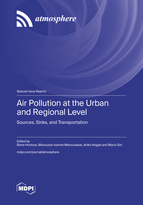Air Pollution at the Urban and Regional Level: Sources, Sinks, and Transportation
A special issue of Atmosphere (ISSN 2073-4433). This special issue belongs to the section "Air Quality".
Deadline for manuscript submissions: closed (5 August 2022) | Viewed by 28428
Special Issue Editors
Interests: air pollution; air particulate matter; airborne black carbon; source apportionment; precipitation chemistry
Special Issues, Collections and Topics in MDPI journals
Interests: aerosols; source apportionment; elemental analysis; PMF; PM; metals; air pollution
Special Issues, Collections and Topics in MDPI journals
Interests: atmospheric pollution; airborne particulate matter; elemental analysis; source apportionment
Special Issues, Collections and Topics in MDPI journals
Interests: aerosol chemistry and microphysics; particulate matter; air quality; exposure assessment; nanoparticle technology; GHGs
Special Issues, Collections and Topics in MDPI journals
Special Issue Information
Dear Colleagues,
According to the World Health Organization, air pollution is the 10th greatest risk factor for human health. Critical loads and levels of pollutant concentrations are air quality markers for assessing the risk of air pollution impacts to ecosystems. The residence time of pollutants in the atmosphere can extend from several days to months, and the corresponding spatial transportation scales are proportionally large, ranging from local to continental. Emissions from industrial activities, energy production, transport, and waste management activities, as well as natural sources, contribute to various air pollution problems, including reduced visibility, health effects, acid rain, and deposition of nutrients and toxic substances. Urban areas are considered hotspots of air pollution, especially large and densely populated metropolitan areas. Various pollutants, both gaseous and particulate, contribute to the deterioration of atmospheric quality.
The aim of this Special Issue is to gather up-to-date research knowledge aiming at assessing air pollution at the urban and regional level, including both experimental and monitoring studies and mathematical/numerical modeling studies. The issue will focus on source apportionment of particulate air pollutants, their trends, deposition sinks, and inter-urban and regional transport. Additionally, the issue will cover all major aspects of urban aerosol observations, including particulate matter chemical characterization and human exposure assessment.
Dr. Elena Hristova
Dr. Manousos Ioannis Manousakas
Dr. Anikó Angyal
Dr. Maria Gini
Guest Editors
Manuscript Submission Information
Manuscripts should be submitted online at www.mdpi.com by registering and logging in to this website. Once you are registered, click here to go to the submission form. Manuscripts can be submitted until the deadline. All submissions that pass pre-check are peer-reviewed. Accepted papers will be published continuously in the journal (as soon as accepted) and will be listed together on the special issue website. Research articles, review articles as well as short communications are invited. For planned papers, a title and short abstract (about 100 words) can be sent to the Editorial Office for announcement on this website.
Submitted manuscripts should not have been published previously, nor be under consideration for publication elsewhere (except conference proceedings papers). All manuscripts are thoroughly refereed through a single-blind peer-review process. A guide for authors and other relevant information for submission of manuscripts is available on the Instructions for Authors page. Atmosphere is an international peer-reviewed open access monthly journal published by MDPI.
Please visit the Instructions for Authors page before submitting a manuscript. The Article Processing Charge (APC) for publication in this open access journal is 2400 CHF (Swiss Francs). Submitted papers should be well formatted and use good English. Authors may use MDPI's English editing service prior to publication or during author revisions.
Keywords
- Air pollutants
- Particulate matter (PM)
- Particulate matter chemical characterization
- Long-range transport
- Wet deposition
- Source apportionment
- Air pollution modelling
- Air quality impact on health









